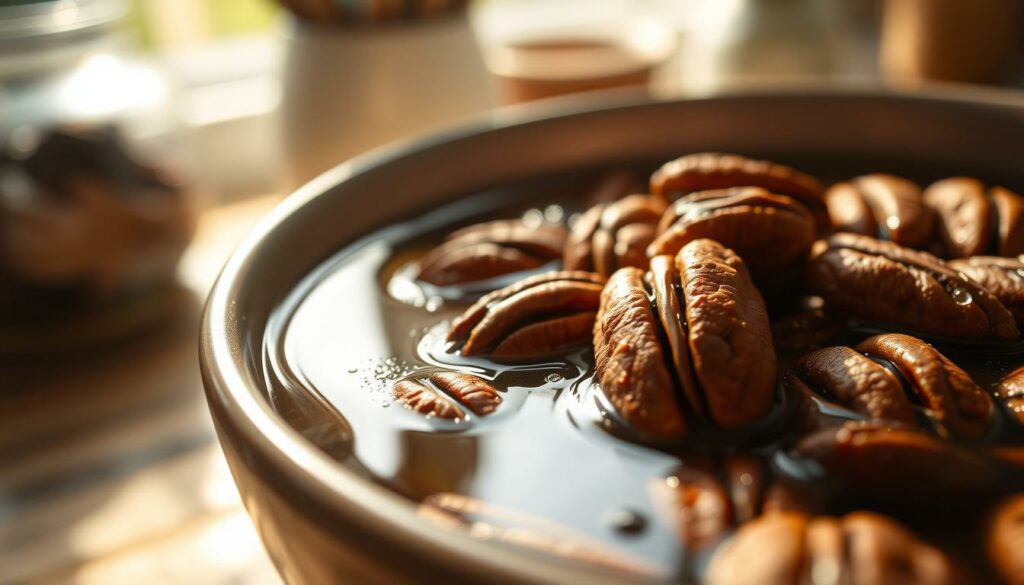Ever wondered why recipes often ask you to soak pecans before roasting? This step can greatly improve your pecans’ flavor, texture, and quality. Soaking pecans is a key method that enhances your dishes, making it a must-try for anyone wanting to improve their cooking.
Soaking pecans before roasting makes them more tender and flavorful. This is especially true for recipes like stuffings, where you want a softer texture. It also removes bitter tannins from the skins, making the pecans taste better.
Soaking pecans also makes them easier to digest and helps your body absorb more nutrients. It breaks down substances that can block mineral absorption, like iron and zinc. Soaking your pecans makes them not only tastier but also more nutritious for you.
Table of contents
Key Takeaways
- Soaking pecans before roasting enhances their flavor, texture, and digestibility.
- This pecan preparation method helps to remove bitter tannins from the pecan skins.
- Soaking breaks down enzyme inhibitors and phytic acid, improving nutrient absorption.
- Soaked pecans are perfect for recipes like stuffings, where a softer texture is desired.
- By soaking pecans, you create a more delicious and nourishing ingredient for your culinary creations.
The Benefits of Soaking Pecans Before Roasting
Soaking pecans before roasting is a simple yet effective technique. It can significantly improve the flavor, texture, and nutritional value of these delicious nuts. By taking the time to soak your pecans, you can unlock their full potential and elevate your culinary creations to new heights.
Enhancing Pecan Flavor and Texture
Soaking pecans enhances their flavor and texture. When pecans are soaked, they absorb moisture. This results in a more tender and crispy texture after roasting. This pecan moisture retention technique allows the nuts to develop a richer, more complex flavor profile that will tantalize your taste buds.
The table below compares the texture and flavor of soaked and unsoaked pecans after roasting:
| Pecan Type | Texture | Flavor |
|---|---|---|
| Soaked Pecans | Tender and crispy | Rich, complex, and enhanced |
| Unsoaked Pecans | Drier and less crispy | Less developed and one-dimensional |
Improving Digestibility and Nutrient Absorption
Soaking pecans can also improve their digestibility and nutrient absorption. Pecans contain enzyme inhibitors that can interfere with proper digestion. But soaking helps to break down these inhibitors, making the nuts easier for your body to process and absorb the valuable nutrients they contain.
“Soaking pecans activates beneficial enzymes that not only improve digestibility but also increase the bioavailability of essential vitamins and minerals.”
By incorporating soaked pecans into your favorite pecan culinary techniques, such as roasting, baking, or garnishing, you can create dishes that are not only delicious but also more nourishing for your body. Soaking pecans is a simple step that can have a significant impact on the overall quality and nutritional value of your pecan-based creations.
The Science Behind Soaking Pecans
Ever wondered why pecans are soaked before roasting? It’s not just a tradition. Soaking pecans has a science behind it that boosts their flavor, texture, and nutrition.
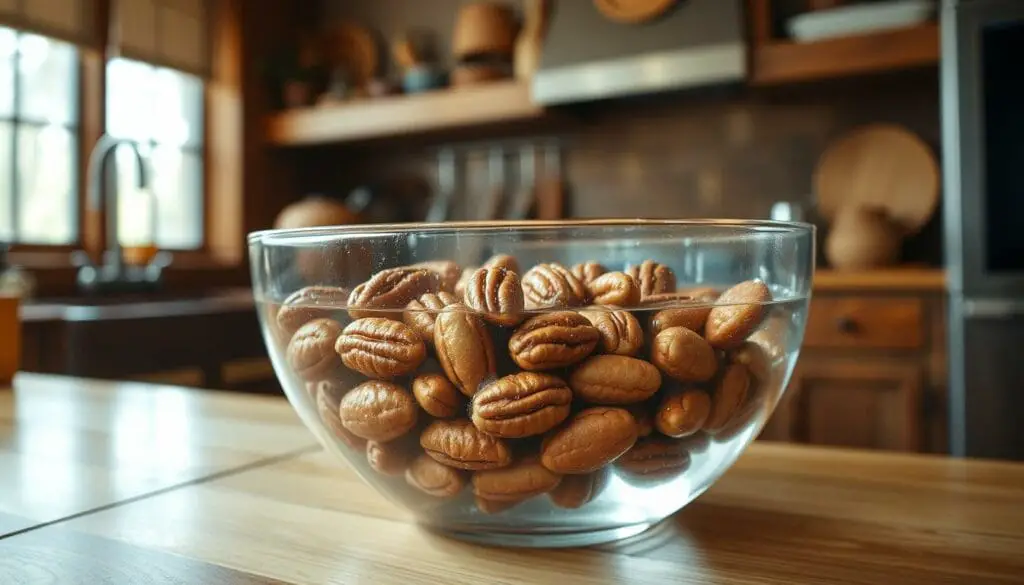
Soaking pecans changes them in a cool way. It breaks down phytic acid and enzyme inhibitors. These can block nutrient absorption, reducing the health benefits of pecans.
Breaking Down Phytic Acid and Enzyme Inhibitors
Phytic acid is an antioxidant in plant seeds like pecans. It protects the plant but can bind to minerals, making them hard to digest. Soaking pecans reduces phytic acid, helping your body absorb more minerals.
Enzyme inhibitors slow down digestion. Soaking pecans neutralizes these inhibitors. This makes it easier for your body to digest the nuts and get their nutrients.
Activating Beneficial Enzymes
Soaking pecans also activates good enzymes. These enzymes improve the nuts’ nutritional value and digestibility. Soaking pecans starts the germination process, releasing these enzymes.
Some key enzymes include:
- Phytase: Helps break down phytic acid for better mineral absorption.
- Lipase: Aids in fat digestion, making pecans’ healthy fats more available.
- Amylase: Breaks down complex carbs, making pecans easier to digest.
These enzymes boost pecans’ nutritional profile and make them easier to digest. This reduces the risk of discomfort or bloating from unsoaked nuts.
| Nutrient | Amount per 1 oz (28g) of Pecans |
|---|---|
| Calories | 196 |
| Total Fat | 20.4g |
| Protein | 2.6g |
| Carbohydrates | 3.9g |
| Dietary Fiber | 2.7g |
Understanding the science behind soaking pecans reveals its many benefits. It enhances your cooking and health. So, remember to soak pecans before roasting them!
How to Soak Pecans for Optimal Results
Soaking pecans before roasting can make them taste better, feel softer, and be more nutritious. The right soaking liquid and time can bring out the best in your pecans. Here’s a simple guide to soaking pecans for the best results.
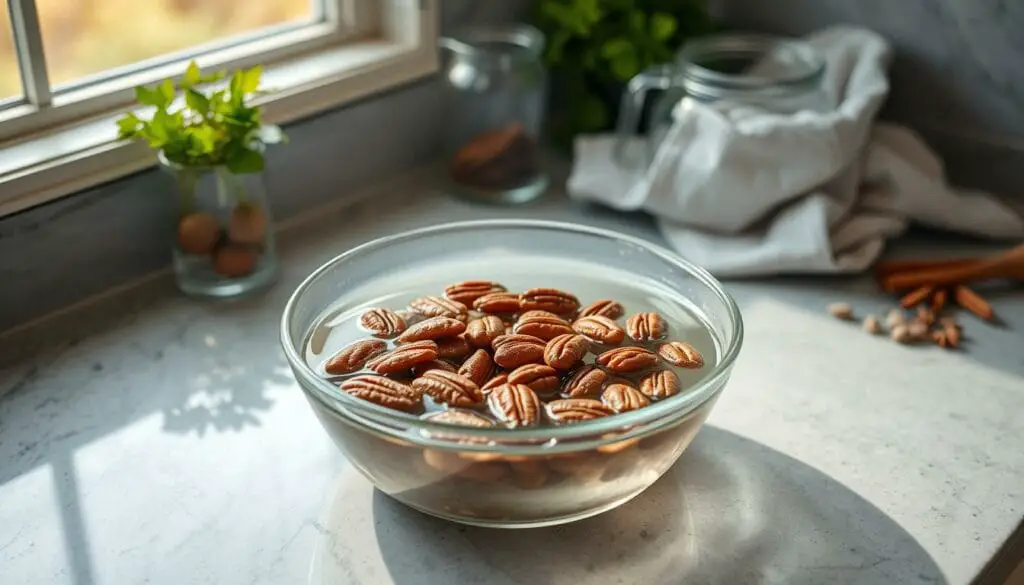
Choosing the Right Soaking Liquid
The liquid you soak pecans in can change their taste and feel. Water is simple, but adding salt can make them easier to digest and taste better. For something different, try using honey for a sweet and complex flavor.
Determining the Ideal Soaking Time
The soaking time affects the pecans’ texture and taste. Soaking for 4-6 hours makes them slightly softer and milder. Longer soaking, 8-12 hours, makes them softer and more flavorful. But soaking too long can make them too soft and lose their crunch.
Properly Draining and Drying Soaked Pecans
After soaking, it’s important to drain and dry the pecans well before roasting. Use a colander to get rid of the soaking liquid. Then, spread them on a clean towel or paper towels. Pat them dry to remove extra moisture. This ensures they roast evenly and stay crispy.
By soaking pecans the right way, you can make them taste better, feel softer, and be more nutritious. Try different liquids and soaking times to find what you like best. A little extra effort in preparation leads to delicious, crispy pecans that everyone will love.
Why Do You Soak Pecans Before Roasting
Soaking pecans before roasting makes them taste better, feel softer, and get more nutritious. This step helps them become tender and crispy when roasted. It’s a simple trick that makes a big difference.
Soaking pecans does more than just improve their taste and texture. It also breaks down harmful compounds that can block nutrient absorption. This means your body can better use the good stuff in pecans, like healthy fats and minerals.
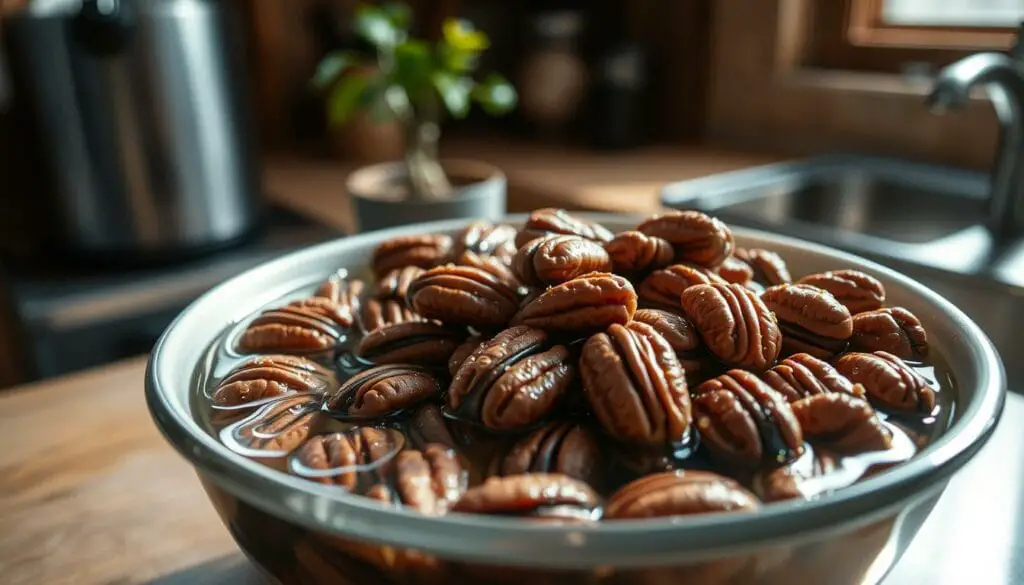
To soak pecans right, pick the best liquid and soak time. You can use water, saltwater, buttermilk, or coconut milk. The soaking time can be anywhere from 4 hours to overnight.
After soaking, make sure to drain and dry the pecans well. This step is key to getting them crispy when roasted.
Here’s how soaking changes the game for pecans:
| Soaked Pecans | Unsoaked Pecans |
|---|---|
| More tender and crispy texture | Drier and less crispy texture |
| Enhanced flavor | Less pronounced flavor |
| Improved digestibility and nutrient absorption | Higher levels of phytic acid and enzyme inhibitors |
| May require slightly longer roasting time | Roasts more quickly |
Soaking pecans before roasting makes them more delicious, nutritious, and enjoyable. Next time you roast pecans, try soaking them. Your taste buds will love it!
Comparing Soaked vs. Unsoaked Pecans in Roasting
When roasting pecans, you might wonder if soaking them first matters. Soaking pecans before roasting can change their taste, texture, and how they roast. Let’s explore how soaked and unsoaked pecans differ when roasting.
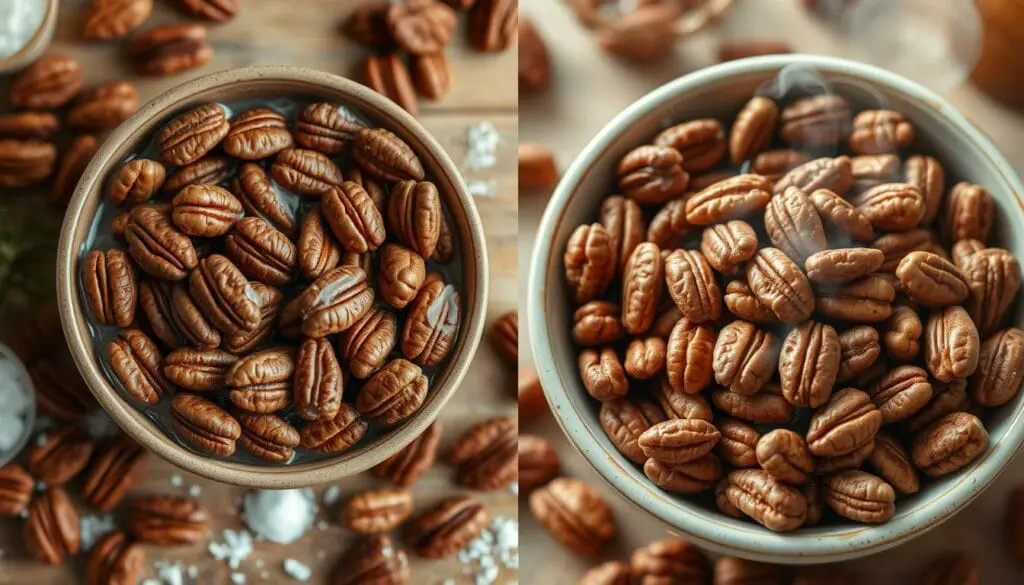
Differences in Flavor and Texture
Soaked pecans are softer and crunchier after roasting than unsoaked ones. Soaking makes them tender, leading to a better crunch. This is because soaking softens the pecans.
Soaking also boosts their nutty flavor. The soaked vs unsoaked pecans taste shows soaked pecans taste richer. Soaking adds moisture, enhancing their taste.
Impact on Roasting Time and Temperature
Soaking changes how pecans roast. Soaked pecans need longer, lower heat to get crispy. This is because soaking increases pecan moisture retention. It helps roast them evenly without burning.
| Pecan Type | Texture | Flavor | Roasting Time | Roasting Temperature |
|---|---|---|---|---|
| Soaked Pecans | Tender and crispy | Enhanced nutty taste | Slightly longer | Lower temperature |
| Unsoaked Pecans | Firmer and less crispy | Milder nutty flavor | Slightly shorter | Higher temperature |
The table shows soaked pecans are better in texture and taste. But, adjust roasting time and temperature for the best results.
Soaking pecans before roasting is a game-changer. The improved texture and intensified flavor make all the difference in the final product.
Whether you like unsoaked pecans for ease or soaked for better taste, knowing the differences helps you get the best roasted pecans.
Soaking Pecans for Various Culinary Applications
Soaked and roasted pecans are great for many dishes. They add depth, texture, and crunch. They’re perfect for cooking and baking.
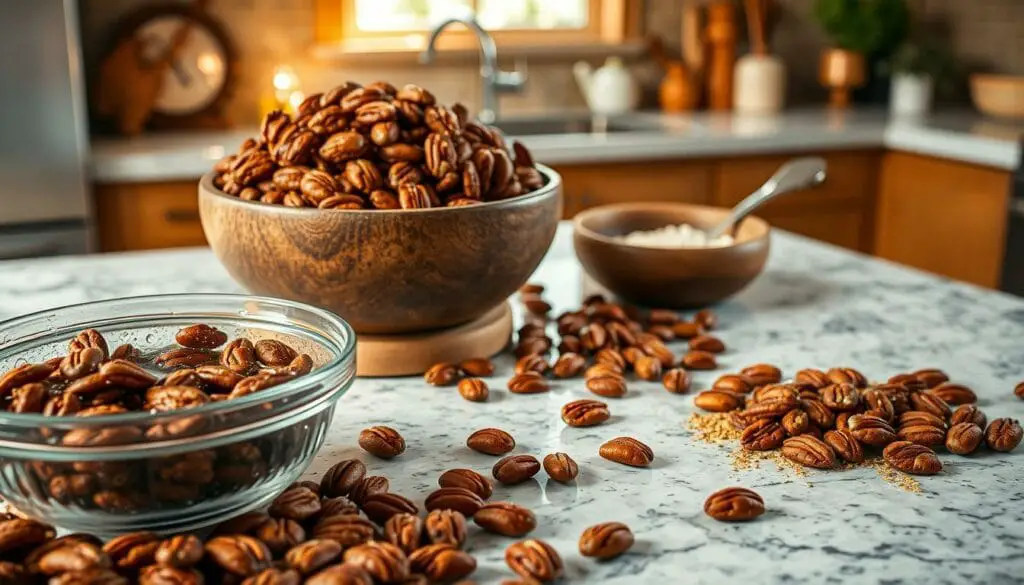
Roasting Pecans for Snacking and Garnishing
Roasted pecans make a tasty snack. The roasting brings out their sweetness and nuttiness. They’re also great on salads for a crunchy texture.
Try them on a spinach salad with cranberries and goat cheese. It’s a gourmet twist.
Using Soaked Pecans in Baking and Cooking
Soaked and roasted pecans enhance your baking and cooking. Add them to cookies, muffins, or bread for extra flavor. They make pecan pie even better, with a tender filling.
In savory dishes, they add depth. Use them in stuffings, casseroles, or as a crust for fish or chicken.
| Culinary Application | Pecan Culinary Techniques |
|---|---|
| Snacking | Roast soaked pecans with salt and spices for a satisfying snack |
| Salad Garnish | Sprinkle chopped roasted pecans over salads for added crunch |
| Baking | Incorporate soaked pecans into cookies, muffins, and pies |
| Savory Dishes | Use chopped soaked pecans in stuffings, casseroles, and as a crust for proteins |
Try these pecan culinary techniques and pecan cooking hacks. You’ll find new ways to use soaked and roasted pecans. They’ll make your dishes stand out, impressing everyone.
Expert Tips for Perfecting Soaked and Roasted Pecans
To get the best results with soaked and roasted pecans, consider a few key factors. Follow these expert tips to make sure your pecans are full of flavor and have the right texture every time.
Selecting High-Quality Pecans for Soaking and Roasting
Start by picking high-quality, fresh pecans. Look for pecans that are the same size and color. Make sure they don’t have mold or decay.
Choose pecans that smell good and feel heavy. This means they have more meat inside.
When picking pecans, think about these things:
- Freshness: Go for pecans that were picked recently for the best taste and texture.
- Size: Pecans that are the same size soak and roast better.
- Shell quality: Stay away from pecans with broken or damaged shells. This could mean they’re not good quality or might be contaminated.
Storing Soaked and Roasted Pecans for Optimal Freshness
Keeping your soaked and roasted pecans fresh is key. Let them cool down completely before putting them in an airtight container. This stops moisture from making them soggy or stale.
| Storage Method | Shelf Life |
|---|---|
| Room temperature (airtight container) | 1-2 weeks |
| Refrigerator (airtight container) | 1-2 months |
| Freezer (airtight container or freezer bag) | 6-12 months |
By using these expert tips for pecan preparation methods and pecan roasting tips, you can make your soaked and roasted pecans even better. With top-notch pecans and the right storage, you can enjoy these tasty treats for months.
Incorporating Soaked and Roasted Pecans into a Healthy Diet
Soaked and roasted pecans are a tasty and healthy choice for your diet. They are full of good fats, fiber, and important nutrients. Adding them to your meals and snacks can make your diet more satisfying and nutritious.
It’s easy to add soaked and roasted pecans to your favorite dishes. Sprinkle them on salads, oatmeal, or yogurt for extra flavor and nutrition. They’re also great on baked goods, in trail mix, or granola.
Exploring pecan culinary techniques opens up a world of possibilities. You can use them in sweet treats like pecan pie or in savory dishes like pecan-crusted chicken. Try different pecan cooking hacks to find new ways to enjoy them.
Soaked and roasted pecans are not only tasty but also incredibly versatile. They can easily be incorporated into a wide range of dishes, making them a staple in any healthy kitchen.
To get the most health benefits from soaked and roasted pecans, pair them with other nutrient-rich foods. Mix them with fruits, veggies, lean proteins, and whole grains. This way, you’ll get all the nutrients your body needs.
Adding soaked and roasted pecans to your diet is a simple and tasty way to boost your health. Their rich flavor, satisfying crunch, and high nutrient value make them a superfood. So, add them to your favorite dishes and enjoy the benefits!
Conclusion
Soaking pecans before roasting changes the game for their flavor, texture, and health benefits. It’s all about understanding the science and the benefits of soaking. This way, you can make perfectly crispy and tasty roasted pecans that everyone will love.
Soaking enhances the nutty taste and makes them easier to digest. It also activates good enzymes. By picking the right soaking liquid and soaking time, and then drying the pecans well, you get the best results.
Soaked and roasted pecans are great for snacking, salads, desserts, and recipes. They add nutrition and flavor to any dish. By choosing quality pecans and storing them right, your roasted pecans will stay fresh and delicious.
So, when you wonder why soak pecans before roasting, think of all the benefits and the amazing taste you’ll get. Learn to soak and roast pecans well. It will take your cooking to a whole new level!
FAQ
Why should I soak pecans before roasting?
Soaking pecans before roasting makes them taste better and feel softer. It’s a key step to get nuts that are crispy and full of flavor.
How does soaking pecans improve their flavor and texture?
Soaking pecans makes them absorb moisture. This makes them tender and crispy when roasted.
What are the nutritional benefits of soaking pecans?
Soaking pecans breaks down stuff that can block nutrient absorption. It also activates enzymes that boost their nutritional value.
What is the best way to soak pecans for optimal results?
For the best results, soak pecans in water or salt water. Choose the soaking time based on the texture and flavor you want. Make sure to dry them well before roasting for the crispiest results.
How do soaked pecans differ from unsoaked pecans when roasted?
Soaked pecans are softer and crunchier than unsoaked ones when roasted. They might need a bit longer to roast at a lower temperature to get that perfect crispiness.
How can I use soaked and roasted pecans in my cooking and baking?
Soaked and roasted pecans are great for snacking, adding to salads or desserts, and baking. Their enhanced flavor and texture make them a versatile ingredient in many dishes.
What are some expert tips for storing soaked and roasted pecans?
For the best results, use fresh, high-quality pecans. Store them in an airtight container at room temperature or in the fridge to keep them fresh and crunchy.
Are soaked and roasted pecans a healthy addition to my diet?
Yes, soaked and roasted pecans are a healthy choice. They’re full of good fats, fiber, and nutrients. Adding them to your meals and snacks can be both tasty and nutritious.

